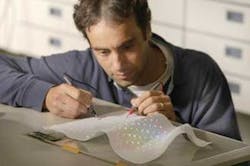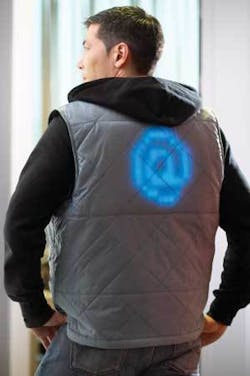FLEXIBLE DISPLAYS: Garments that communicate go into production

Clothing that communicates visually via arrays of light-emitting diodes (LEDs) is out of the lab and moving into production. About a year ago, researchers and engineers at Philips Research (Eindhoven, the Netherlands) announced that they had integrated flexible arrays of multicolored LEDs into fabrics, plastics, and films. Now, they have brought the technology, called Lumalive, to a point where it is ready for commercialization; Philips is particularly interested in reaching companies in the promotional industry looking for a new, high-impact medium. Pop-up ads on people’s backs may not be far off.
The R&D group at Philips says its LED arrays do not compromise the softness of the cloth that contains them. The display’s electronics, batteries, and LED arrays are fully integrated and invisible to the observer and wearer. The first production-ready cloth displays contain 14 × 14 arrays of red-green-blue LEDs and are 200 × 200 mm² in size, although the active sections can be scaled up to cover much larger areas such as a sofa. Although the LEDs are quite small, the enveloping fabric diffuses light, making each pixel seem bigger than it actually is.
But how does one wash a jacket that is part flexible display? “The box with electronics and the batteries must be removed (as you would remove your cell phone from your jacket before washing); the Lumalive panel can be removed, but is water-repellent,” says Bas Zeper, managing director of the photonic-textiles business unit at Philips Research. “Dry cleaning is OK, but you must take the panel out if you want to wash in a washing machine.”Interactive clothing
Capable of full-color animation, the arrays are, of course, computer-savvy. “We now use a USB connection to program the control electronics,” says Zeper. “The system can in principle be extended with Bluetooth. One of the research prototypes can receive SMS messages and display them on the Lumalive textile.” (SMS, or short message service, is nothing other than cell-phone text messaging.) The Philips engineers want to add interactive elements to the light-emitting textiles-for example, a built-in response to touch, movement, or sound via integrated sensors, notes Zeper.
“The first uses will be in clothes for events (promotion, creating attractions), on stage (dance and so on), and the workplace (increase visibility and safety); secondly in furniture (reception, lounges),” he says. The fabric was introduced by Philips to the public in the form of jackets and furniture at this year’s Internationale Funkausstellung consumer-electronics show (Sept. 1-6; Berlin, Germany).
While the garment-as-display concept has been bandied about for years, its incipient introduction into the real world begs for speculation on its potential. It’s not hard to imagine communicating with someone across a noise-filled space at the airport or mall, perhaps one letter or word at a time (although the messaging would be far from private). It’s even conceivable that a new version of the shorthand developed for Internet instant messaging will one day emerge for jacket-to-jacket (J2J) use.
About the Author
John Wallace
Senior Technical Editor (1998-2022)
John Wallace was with Laser Focus World for nearly 25 years, retiring in late June 2022. He obtained a bachelor's degree in mechanical engineering and physics at Rutgers University and a master's in optical engineering at the University of Rochester. Before becoming an editor, John worked as an engineer at RCA, Exxon, Eastman Kodak, and GCA Corporation.

